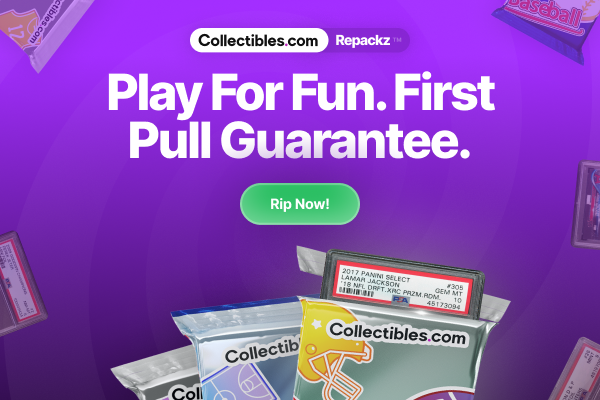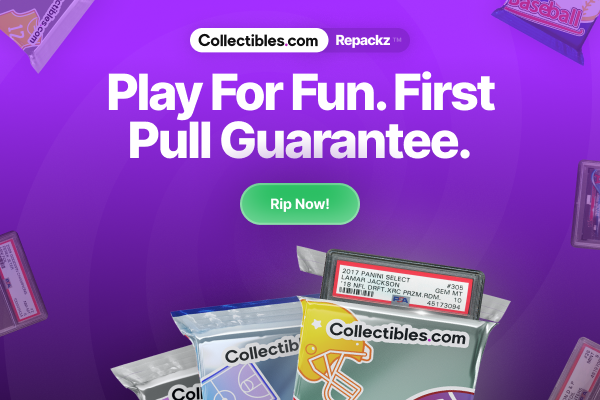
Does the 2014 Bowman Chrome Kris Bryant Autograph Set a Dangerous Precedent?
 In case you hadn't heard, Kris Bryant has some surprise autographs in 2014 Bowman Chrome Baseball. And while the cards of the 2014 Minor League Player of the Year trump just about everything else in the release, they could set a dangerous precedent for the hobby. The reason is that the Chrome Kris Bryant autographs that were a major selling point for 2014 Bowman Baseball are now in 2014 Bowman Chrome Baseball as well -- the same card, not a variation. And while this is likely to be a one-off exception, it could have some serious implications for the high-end card market.
In case you hadn't heard, Kris Bryant has some surprise autographs in 2014 Bowman Chrome Baseball. And while the cards of the 2014 Minor League Player of the Year trump just about everything else in the release, they could set a dangerous precedent for the hobby. The reason is that the Chrome Kris Bryant autographs that were a major selling point for 2014 Bowman Baseball are now in 2014 Bowman Chrome Baseball as well -- the same card, not a variation. And while this is likely to be a one-off exception, it could have some serious implications for the high-end card market.
While Bowman and Bowman Chrome can be considered in the same family, they are entirely different releases. Although not serial numbered, there was already a seemingly finite supply when the Kris Bryant Chrome autographs were released earlier in the year. Now, those that spent hundreds of dollars on the card under this assumption of limited supply are seeing a new wave of the same cards hitting the secondary market.
And when you think about it, from a collectibles standpoint, it's kind of a scary situation.
One could view the additional Kris Bryant autographs as a bonus. And for those who land one with a random 2014 Bowman Chrome pack or box, they're likely going to be ecstatic.
However, the message it sends is one where it's okay to release the same card over again. A big part of the appeal of a big-time card like the 2014 Bowman Chrome Kris Bryant autograph is that demand outpaces supply. Now that there's all of a sudden a larger supply, where does it send prices?
Besides the added amount, another issue is the fact that collectors weren't alerted of the unique situation in advance. Topps' decision to split up the print run was not made public. It wasn't on the final 2014 Bowman Chrome checklist released by the card maker either.
Had the scenario been divulged back when 2014 Bowman Baseball was first released, it wouldn't be much of an issue. Those in the market for the card could have planned accordingly knowing there were more to come. Instead, it came out of the blue.
In this situation, the move probably only affects a few hundred collectors who were holding onto 2014 Bowman Chrome Prospect Autograph Kris Bryant cards already. But what's stopping Topps or any other card company from intentionally holding back cards for a later release? Or, even worse, actually going back and printing more of the same card after the fact?
Even with pack warnings and disclaimers distancing card companies from secondary market values, they are aware that the market exists for single-card sales. It's that secondary market, and the value it brings, that takes a card from being just a thing to being a collectible. It's safe to say that when hobby shops started popping up, price guides started being published and the gum stopped that sports cards crossed the line into the collectible realm.
Now, even when collectors are building a low-end set, perceived value usually comes into play with purchases. Even if "value" isn't a driver for the sale, it is part of a lot of decisions. That puts a high level of responsibility onto the shoulders of manufacturers to maintain that. However, re-releasing a card can easily put things out of whack.
The 2014 Bowman Chrome Kris Bryant autograph is far from the first time that cards have resurfaced. We have all sorts of buybacks now. However, they're marketed under the belief that they come from an already released supply. They're also usually marked with some sort of stamp. This not only differentiates them from other cards but also creates an entirely new card for collectors.
Collectors can also look back to update sets that had earlier cards in them. Perhaps the best example of this is the early Upper Deck sets. Updated High Series packs had not only new cards but the first series as well.
But that was a whole new set. With 2014 Bowman Chrome Baseball, it's just one card and some parallels. It's also the top card in 2014 Bowman Baseball.
On the other end of the spectrum, one could also look back to 1990-91 Upper Deck French Hockey. When it first came out, the perception of rarity drove prices extremely high. But then allegations of more being printed combined with a massive surplus on the market drove prices down to the point where they hardly command a premium over their common English counterparts now.
On a whole, Kris Bryant autographs have been created several unique instances this year. It started with the 2014 Bowman Baseball Mystery Redemptions. In the past, several different cards have been created to capitalize on high-profile players making in-season debuts. This year, though, all five are good for the same Kris Bryant Refractor Autographs, the parallel version of the main card.
The next surprise came when 2013 Bowman Chrome Draft Kris Bryant autographs surfaced in 2014 Bowman Inception Baseball. More were inserted in 2014 Bowman Platinum Baseball. Even more, including colored Refractors, have surfaced in 2014 Bowman Chrome Baseball.
While these have caused some confusion and discussion, particularly from collectors trying to figure out which one should be Bryant's first Chrome autograph, these really are a bonus. They have never been advertised as being part of one particular set and they're giving more collectors a chance at Kris Bryant autographs.
So does having the 2014 Bowman cards in Bowman Chrome, but it's very different. This is a card that was included on a checklist for a particular set. Supply, even if not announced, was assumed because there isn't a history of the exact same card coming in two separate releases. But then more show up and you can't help but question the original supply.
Experimenting with sets and distribution isn't necessarily a bad thing. But it's important to keep collectors in the loop so they know what to expect and can plan accordingly. If communicated up front, splitting a card's supply up between multiple sets can make both products stronger. Or, if it's going to be a surprise, add a stamp or make the second card different in some form. However, just dropping it on the hobby without warning can be dangerous.
We did reach out to Topps about the situation but have not heard back from them. We'll be sure to update if we do get a response.
What do you think? Are you happy there are more 2014 Bowman Chrome Kris Bryant autographs in 2014 Bowman Chrome Baseball? Do you want to see more of this in the future? Let us know in the comments below.
 | Making purchases through affiliate links can earn the site a commission |





























Mike M
Garciatheone made a good point. People on ebay with their asking prices certainly CAN go fly a friggin kite!
I also disargree with Jamey Feuer and side with Topps when he said: “the manufacturer is scamming if not defrauding the consumer. […] Manufacturers can deny the inherent value of cards all they wish, but cards are collectible commodities founded upon finite print runs. When the run is anyone’s guess? So too is the value.”
Baseball cards are not a “commodity” for investment, in the same sense that real estate or stock in a company or government-issue bonds are.
Yes, the market prices work in much the same manner as those things. But a baseball card has no actual intrinsic value. That is to say, they are not used to produce more wealth. Real estate can be developed. Companies produce goods and services that people consume. Government bonds are promissory notes backed up by the full faith of the government so it can pay for unforeseen expenses.
And baseball card companies like Topps certainly can increase a production run if they see demand rising, much like a car company can produce more cars in order to keep up with demand. The problem with overproduction in card companies is the can with car companies: Too much overproduction can cheapen prices to the point where they either cannot sell anymore, or must reduce their prices. In the case of baseball cards, they are not an essential necessity like cars can be for a modern economy to thrive. The card flippers can quit if they so choose without much affecting their lifestyle. And yes, that would hurt Topps. But there are still going to be the casual collectors such as myself that will keep them in business, albeit, with reduced demand.
And with reduced demand, goes reduced production runs. Reduced production runs, could mean an increase in demand agagin, with an increase in prices. We’ve seen this happen before in the 80s and 90s. A flood of cards on the market killed many card companies such as Fleer. Those that stuck around like Topps and Panini, had to scale back their operations. Starting in the mid 2000s or so, the market started coming back due to limited production runs, which was the cause of limited demand.
What Topps has to be careful of, is manufacturing rarity. The combination of the god aweful lot of parallels and subsets makes card collecting confusing and too much of a headache with the average collectors; plus the issue featured in this article that frustrates the card flippers.
I always thought that was the purpose between all these different brands and sets under the Topps name. Perhaps that was the point when they started doing that: Offer a little something for each different niche of hobbyists. But I mean, christ, they are trying to branch out in all different directions for each different brand!
Sorry for the rambling.